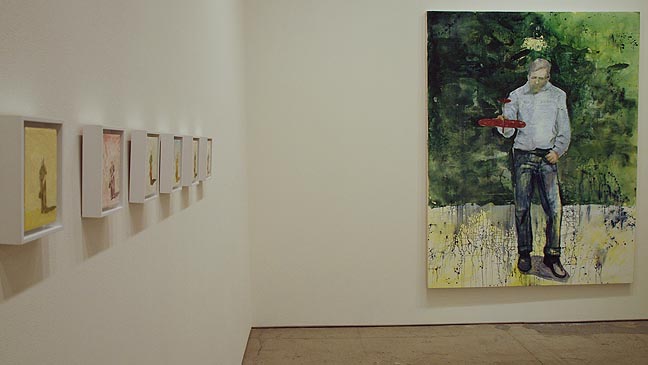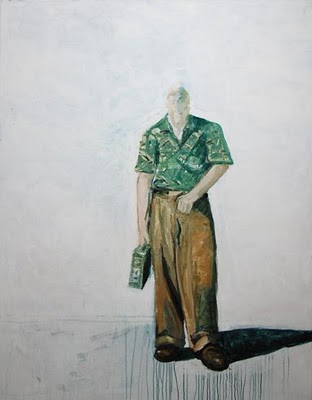
|
||
|
Portland art blog + news + exhibition reviews + galleries + contemporary northwest art
|
||
Drake Deknatel's Small Paintings at Elizabeth Leach  Drake Deknatel at Elizabeth Leach Gallery As a relative newcomer to the greater Northwest art community, I am often at a loss when discussions arise regarding all but the most prominent of local artists. The upside of this situation is that it is still possible for me to be surprised. Cris Bruch suggested that I see the paintings of the late Drake Deknatel. While I took his recommendation under advisement, I didn’t think I’d be writing about Deknatel’s work, first, because that would mean two reviews of Leach exhibits in as many months, and because I don’t have a strong relationship with a lot of contemporary painting. I will, however, admit to a long-held notion that fertile ground can be found in the medium when a painter plays with the boundaries of abstraction and figuration. I am not alone in this notion, or in the assessment that Deknatel’s painting often succeeds in this challenge, especially in the work just prior to his death in 2005. The surfaces of his canvasses are richly textured, and the figures, while standing apart, also blend with the field in which they are positioned, thereby reinforcing the dynamic quality of the work. To over-use a phrase, Deknatel is clearly a painter’s painter, which is all well and good, for his proficiency with paint will hold one’s gaze; however, it is still not enough to make me put pen to paper merely to reiterate what has already been better said elsewhere. Leach has titled this exhibit, “Small Paintings.” The paintings are arranged in two groupings, each with one large painting and several corresponding smaller paintings. One group shows a person holding what appears to be a satchel. The large painting in this first group is titled “Boy Sisyphus” (2005). The smaller ones in this grouping are untitled, but all have notations on the back that read either “Figure with Ammo” or “Man with Ammo”. The second group revolves around a large painting in which a figure stands with a similar posture to the other set, yet in this group holds a toy airplane. All of this second set is untitled, although the large piece has the notation “I wish I could fly”, and for the small ones, “Figure with plane”. The treatment in all of the small paintings from both groupings varies significantly from that of the large paintings, as well as between themselves. As studies, the palette, textures and details of the surface and figure change, and their interest lies in those differences. Even so, one must ultimately return to the large paintings that they reference.  Deknatel's Boy Sisyphus In Deknatel’s “Boy Sisyphus”, no mountain is visible, as the background is an over-painted void. However, the figure is shaped somewhat like a pyramid with very large feet and a smallish head. If the boy in the picture has a boulder to push ahead of him time and again up a mountain, it may be an inner struggle. The other large painting, annotated with “I wish I could fly”, suggests a desire to escape or rise above. Overall, “Small Paintings” consists of reflections on the artist’s youth, and nostalgia of that sort, particularly when life becomes tenuous, necessarily encompasses a meditation on mortality. The mood in Leach’s back room takes on a somber tone despite the vibrant colors. Drake Deknatel died of a heart attack not long after having open-heart surgery. Many of the small paintings at Leach were completed during his presumed convalescence. These facts are thoroughly covered in the number of articles and eulogies written shortly after and since his death, and it is therefore almost impossible to relate to the paintings on any other terms than from the romantic notion that beauty sometimes comes with facing the inevitable. Regret turns to release. But Deknatel’s message, not only for those among us who are of sufficient years or similar health, but for all with eyes to see, would not be so poignant without his mastery of the medium. Posted by Patrick Collier on August 21, 2010 at 15:07 | Comments (0) Comments Post a comment Thanks for signing in, . Now you can comment. (sign out)
(If you haven't left a comment here before, you may need to be approved by
the site owner before your comment will appear. Until then, it won't appear
on the entry. Thanks for waiting.)
|
| s p o n s o r s |
 |
 |
 |
 |
 |
 |
 |
 |
 |
 |
 |
 |
 |
 |
 |
 |

|
Site Design: Jennifer Armbrust | • | Site Development: Philippe Blanc & Katherine Bovee | |

